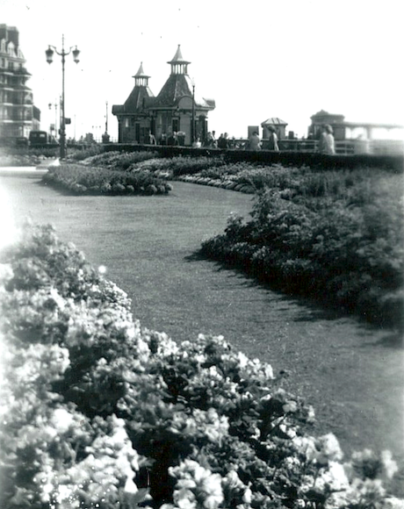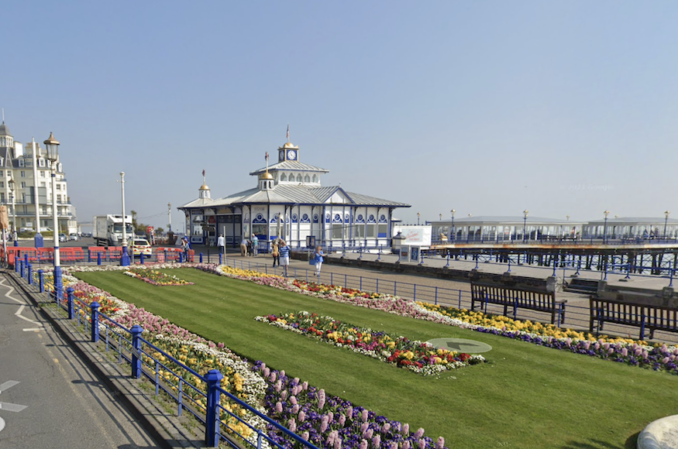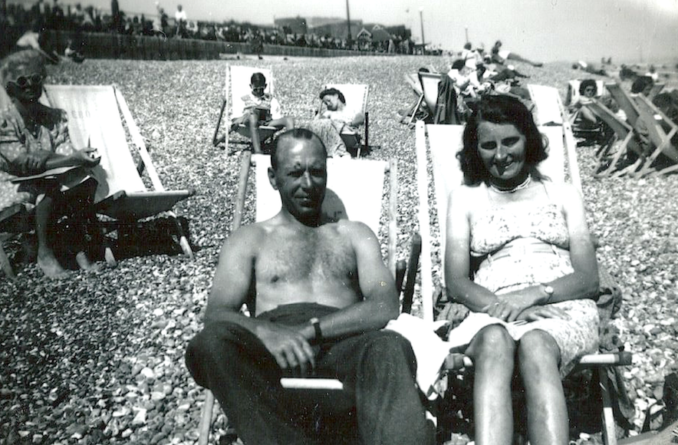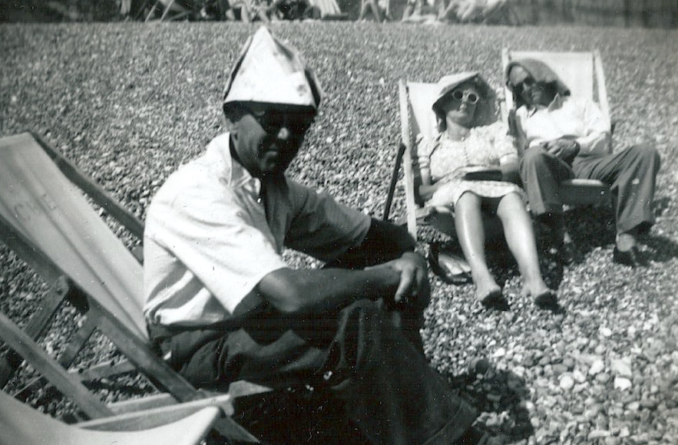Eastbourne is a charming seaside resort town situated in East Sussex on the south coast. Known for its Victorian seafront, it lies 19 miles east of Brighton and 54 miles south of London. According to its own tourist office, it is the sunniest town in the UK. Other tourist office opinions are available and they, particularly Morecambe’s, may disagree. The town boasts a rich history, with evidence of human occupation dating back to the Stone Age. The area was settled by Celtic people in 500 BC and the town has seen many name changes since, with ‘East’ added to ‘Bourne’ in the 13th century.
These days the town is home to the largest man-made marina in Europe and, again according to the tourist office and despite the best efforts of the local water company, is known for its ‘excellent seawater quality’. Eastbourne’s economy heavily relies on tourism, supplemented by conferences, cultural sightseeing, and public events. It has several attractions such as a pier, a theatre, an art gallery, and a military museum. The town was also the most bombed seaside town in England during WWII.

© Always Worth Saying 2023, Going Postal

© Google Street View 2023, Google.com
Eastbourne’s promenade is a delightful five-mile stretch along the seafront, offering stunning views of the Channel, with towering green bluffs and cliffs. Nowadays it is wheelchair and pushchair friendly, providing a mainly level walk. The walkway is rich with attractions; you’ll pass through beautifully maintained gardens, the Lifeboat Museum, the Wishtower Slopes, and the Western Lawns. Further, the promenade boasts of a Victorian pier, Bandstand, Carpet Gardens and so much more. Some additional paths in the parks can further enhance your experience. This serene location is ideal for a leisurely stroll or bike ride, with plenty to see and do along the way. The promenade is lined with grand Victorian hotels that add a touch of historical charm to the seaside town.
In the top photograph you can see Eastbourne Gardens pictured in 1948 during my grandparents’ visit. Below, a Street View image reveals an apparent improvement for once – from some angles. The building on the left has survived too and is the Queen’s Hotel. However, having a scout about on the link shows that the developers are a work!
To the right, Eastbourne Pier is a thousand-foot-long Victorian seaside pleasure pier. It was officially opened on June 13, 1870, and is an iconic feature of the Eastbourne seafront. The pier is designed in a classic British style with a variety of vendors, including shops, cafes, and amusement arcades. It also features a camera obscura, a device that projects an image of the surroundings onto a screen. The pier has endured several disasters, including storms, bombs and fires in 1970 and 2014, but has been refurbished each time. Despite these challenges, Eastbourne Pier continues to be a beloved part of the city’s heritage and a key tourist attraction.
Eastbourne Beach extends for over three miles, offering a vast expanse of shingle and, at low tide, areas of sand and opportunities for rock pooling. The beach is also a hub for various activities such as windsurfing and fishing, and it houses a Marine Conservation Area at Holywell. Furthermore, the main resort beach is equipped with facilities like lifeguards, a kid’s wristband scheme, and swimming-only zones. Amenities like toilets, cafes, beach huts, and deckchairs are also available for hire.

© Always Worth Saying 2023, Going Postal

© Always Worth Saying 2023, Going Postal
The beach is prone to coastal erosion due to longshore drift, indicated by the presence of wooden groynes. Despite these natural challenges, the water quality at Eastbourne Beach is rated as ‘excellent’. Eastbourne also allows for day trip opportunities to other parts of Sussex. Interestingly, when the photos were taken in 1948, my grandfather was 42 and my grandmother only 38. Hard lives lived during hard times that included two world wars.
Newhaven
Newhaven is a historically significant port town located in East Sussex, thirteen miles along the coast in the direction of Brighton. It lies at the mouth of the River Ouse and developed during the Middle Ages when the nearby port of Seaford dried up. The town saw the construction of a sheltered harbour and breakwater in the 16th and 18th centuries, which significantly increased its importance, especially after the arrival of the railway in 1847.
Newhaven continues to operate regular ferry services, although these have been reduced in the 21st century. It also functions as an important freight terminal, with international ferries running to the French port of Dieppe, operated by DFDS Seaways. Notably, the port is the main landside site for E.ON’s offshore Rampion Wind Farm development and its planned extension.
The town is home to Newhaven Fort, which has stood since the 19th century. Newhaven also hosts a Nature Reserve, Tide Mills, and Paradise Park, which houses a museum and an enterprise centre. Every summer, the town celebrates its history in the fishing industry with a Fish Festival. These days the local economy is supported by light industry, boatbuilding, and tourism.
Despite its reputation as a grimy port, Newhaven has become a staycation spot with hidden surprises. It boasts two marinas, a rowers club, a ferry to Dieppe, West Beach (the only sandy beach on the South Coast), the Napoleonic Fort, specialist shops, great restaurants, and pubs such as the Bridge Inn and The Hope Inn. It also offers easy access to Brighton, London, and the South Downs.
Newhaven Harbour is a significant feature of the town, serving as both a ferry terminal and a freight terminal. It’s a bustling hub of activity, with those regular services to France. The harbour is also a key player in the transport of goods, contributing significantly to the local economy. The harbour is sheltered by a sizable breakwater, making it a safe anchorage for ships. In addition to its practical uses, the harbour offers scenic views and is a popular spot for leisure activities such as fishing and boat trips. The Newhaven Marina, located within the harbour, provides mooring for a variety of vessels, adding to the harbour’s vibrant atmosphere.
Historically, during both World Wars, Newhaven played a pivotal and crucial role. In World War I, it served as a base for naval ships and was a principal port for the movement of men and materials to the European continent. In World War II, Canadian troops were stationed in large numbers in Newhaven and the port played an important part in Operation Overlord, the Allied invasion of Nazi-occupied Europe.
Post-war, the harbour transitioned into a bustling hub for ferry and freight services. Today, it continues to operate as a crucial link for trade and transport between Britain and the continent, while also offering scenic views and leisure activities for locals and tourists alike. The Newhaven Marina, located within the harbour, adds to the vibrant atmosphere with its array of boats and yachts.

© Always Worth Saying 2023, Going Postal
In the photograph, we can see my grandfather sitting on the Westside Breakwater with the East Pier behind him. My grandparents will have driven around the side of the said fort, dropping as they did so, to the harbour front where they will have parked up for a wander along the breakwater.
In front of him are some distinctive dockside rails. Note the metal sleepers and a wooden peg beneath the rail. At first, this unusual arrangement led me to suspect this to be for a rail-bourne dock crane but further investigation revealed that it was a branch line – of sorts.
Locals report a Terrier Class steam engine 2636 ‘Fenchurch’ worked a line which ran from the old (manually powered!) Victorian swing bridge across the Ouse, around the fort, down to the quayside and all the way to a lighthouse at the end of the breakwater.
A crane did work along the line but was locomotive-hauled. The little engine also served the needs of the lighthouse and was used in the repair and maintenance of the breakwater. The railway track was pinned down by steel clips held by bolts screwed directly into the concrete, as at the time of construction there were no wooden sleepers to spare. The line, or tramway as it was referred to, saw its last train on 10th August 1963.
Birling Gap

© Always Worth Saying 2023, Going Postal
Birling Gap is a coastal hamlet, located in the Seven Sisters Country Park, East Sussex, only a couple of miles from last time’s visit to Beachy Head. It’s part of the South Downs National Park and is noted for its pebble beach and chalk cliffs. The hamlet is also recognized for its rapidly eroding coastline, a phenomenon that has resulted in several homes being lost over the years. Despite this, Birling Gap is a popular tourist destination, offering stunning views, scenic walks, and a chance to explore rock pools at low tide. Its visitor centre provides insight into the area’s unique geography and the forces of nature at work.
My grandmother is pictured at the bottom of the gap between Birling and the beach. The stairs that connect the forty-foot-high dip in the white cliffs are to her right. To her left, the undulating chalk cliff tops disappearing around the coast are known as the Seven Sisters, a magnificent stretch of coastline that runs between Newhaven (just about) and Eastbourne.
© Always Worth Saying 2023



